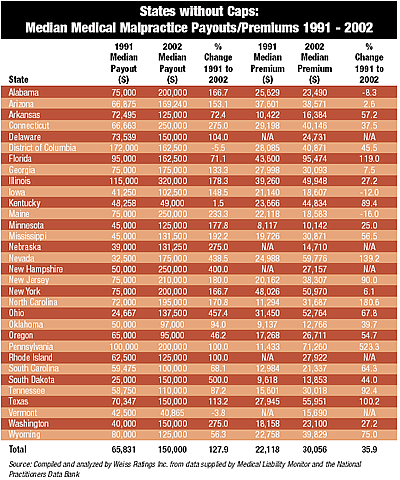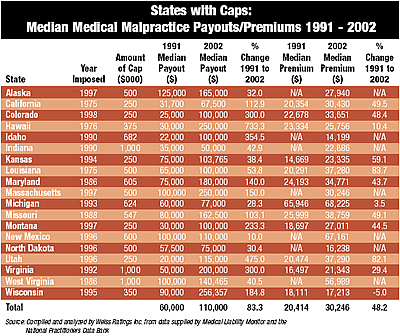Martin D. Weiss, the head of the Florida-based rating service that bears his name, couldn’t have chosen a better way to ramp up the debate over medical malpractice lawsuits, and the increased costs of insurance coverage, than to challenge the perceived wisdom that the two are directly related.

In a widely discussed study, published on June 2, Weiss concluded that damage caps, long advocated by the health care and insurance industries, don’t automatically lead to lowering insurance premiums and called for a moratorium on their imposition. “Caps on non-economic damages have failed to prevent sharp increases in medical malpractice insurance premiums, even though insurers enjoyed a slowdown in their payouts,” said a company announcement. “Tort reform has failed to address the problem of surging medical malpractice premiums, despite the fact that insurers have benefited from a slowdown in the growth of claims,” Weiss stated. “The escalating medical malpractice crisis will not be resolved until the industry and regulators address the other, apparently more powerful, factors driving premiums higher.”

Weiss Ratings, which prides itself on its independence, undertook the study with no preconceptions. “It’s part of our service to examine what’s going on in the industries we cover,” said Weiss vice president Melissa Gannon. “We decided that we could contribute to the debate; we had no hidden agenda, and no one else financed it.” She also observed that practically all of the other studies Weiss looked at had been conducted by the insurance industry, and focused almost exclusively on how caps limit damage payouts.
Weiss’s study compares the Payout/ Premium figures for the 19 states that have passed legislation capping the amount of non-economic damages (chiefly for pain and suffering and punitive awards) and the rest of the states in the U.S. that have no limits (See Charts). It also showed that “in states without caps, the median payout for the entire 12-year period was $116,297, ranging from $75,000 to $220,000, while the median payout for states with caps was 15.7 percent lower, or $98,079, ranging from $50,000 to $190,000” (figure adjusted for inflation).
Weiss found that median premium payments in 2002 in cap and non-cap states were practically identical, slightly over $30,000. It also concluded that while the caps have lowered the amount of claims payments, they don’t appear to have significantly reduced premiums. In fact the study found that “in states with caps, the median annual premium went up by 48.2 percent, but, surprisingly, in states without caps, the median annual premium increased at a slower clip—by 35.9 percent.” It also found that premiums actually declined in “only 10.5 percent” of the states with caps, while in those without caps “18.7 percent experienced flat or declining premiums.”
If Weiss had left it there, the argument might simply have become one over who had the best statistics, but the rating agency went on to identify six other factors that also influence medical malpractice premium rates—”each of which may be exerting a greater impact on premiums than the presence or absence of caps.”
In the following order it cited:
• The medical inflation rate—Medical costs have risen 75 percent since 1991.
• The insurance business cycle—Notably the “12-year ‘soft’ period” that lasted through 1999 and the consequent pursuit of “marketing goals” over “prudent underwriting practices,” coupled with an over-reliance on investment income to make up the difference.
• The need to shore up reserves for policies in force—Med-mal insurers have been “consistently under-reserving since 1997—to the tune of $4.6 billion through Dec. 31, 2001,” according to Weiss, and therefore need to increase premiums to “shore up reserves.”
• A decline in investment income—”23 percent in 2001 and then another 2.5 percent in 2002,” said Weiss, calling the situation “particularly critical for lines of business like med-mal since the duration of claims payouts typically spans several years.”
• Financial safety—”34.4 percent of the nation’s med-mal insurers are vulnerable to financial difficulties,” Weiss found, “compared to 23.9 percent of the property and casualty insurance industry as a whole.” This adds to pressures to increase premium rates in spite of caps.
• Supply and demand for coverage—”The number of med-mal carriers increased through 1997 to 274, but has since fallen to 247 in 2002.”
“We see these same six factors all the time,” said Gannon. “We know what’s happening in the industry; you can’t only look at one side.” While she stressed that caps did indeed appear to slow down payouts, “the assumption that they also reduce premiums just hasn’t happened.”
The predictable, and angry, reaction was not long in coming. On June 5, the Physician Insurance Association of America (PIAA) issued a bulletin calling the Weiss study “fatally flawed.”
The PIAA objected to the use of “median payments” as criteria. It pointed out that “While the use of median payment data shows that cap states fare better than others, it greatly understates the difference by ignoring the spiraling rise in total claim payments caused by a greater proportion of large payments.” It cited Florida as an example where “total claim payments” rose by 141 percent during the period, “according to the National Practitioner Data Bank,” one of the same sources that Weiss used. This finding contrasted with a rise of ‘only’ 47 percent in California” which has had a $250,000 cap on non-economic damages since 1975. The size of the cap, which varies between $250,000 and $1 million also skews the results. The PIAA believes caps in the million-dollar range are largely ineffective.
The PIAA’s Larry Smarr indicated that Weiss’s method could inflate premium increases by not weighting premiums according to market share. This would happen when the same weight is given to a carrier with the highest rates, which in all probability has the lowest market share, as to a carrier with lower rates, which most likely has a higher market share. He also said Weiss had failed to take into account discounts or returns of premium in the form of dividends that insurers routinely pass on to physicians.
The organization also noted that insurers tend wait to lower rates after a cap has been passed, in order to avoid being trapped if it’s later struck down by the courts, as has happened in Illinois and Ohio.
Gannon responded that data could be considered in any number of ways, but that Weiss had elected to use median figures as “we wanted to look at more typical experiences,” rather than considering the most extreme cases. She also stressed that the study’s focus had been to give an overview of the problem, rather than an in depth examination of each state’s med-mal legal claims system.
The PIAA bulletin cited studies by the Congressional Budget Office, the Joint Economic Committee, and the HHS, which it said had “all issued well-researched studies that document the direct relationship between tort reforms, lower payouts, and over the long-term, lower premiums. The Weiss ‘study’ is poorly done and simply out of its league.”
While one can certainly argue over statistics, it’s clear than many states are having real problems with med-mal claims and premium increases, and their doctors and hospitals are determined to find a solution to the problem. In just one week, June 9-13, Pennsylvania’s Governor came out with a reform plan and the State’s Assembly passed a constitutional amendment to allow damage caps. Long Island doctors said health care services were being threatened by a rising tide of med-mal lawsuits, and the Medical Society of New Jersey, which represents a bit less than a third of the State’s physicians, called on the Medical Board to set med-mal policy limits at the same rate as auto insurance—$15,000 in liability coverage for each case and $30,000 per year as the minimum.
Gannon noted that while the rate of premium increases may go down when a damage cap is enacted, “that’s not the ultimate result the doctors are looking for.”
Topics Carriers
Was this article valuable?
Here are more articles you may enjoy.


 Wall Street Pushes Back After Activists Escalate Protests
Wall Street Pushes Back After Activists Escalate Protests  Project 2025 Plan to End NFIP Welcomed by Some, Rejected by Others in Insurance
Project 2025 Plan to End NFIP Welcomed by Some, Rejected by Others in Insurance  Viewpoint: Deepfake Fraud Is On the Rise. Here’s How Insurers Can Respond
Viewpoint: Deepfake Fraud Is On the Rise. Here’s How Insurers Can Respond  Hard Market Conditions Expected to Ease in 2025 as Claims Inflation Softens: Swiss Re
Hard Market Conditions Expected to Ease in 2025 as Claims Inflation Softens: Swiss Re 


